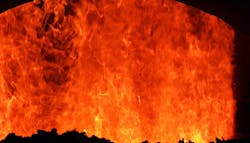Two recent columns discuss boiler efficiency and ways to improve it (see, “Get Fired Up” and “Improve Fired Equipment Efficiency”). However, achieving gains usually requires not only an engineer who understands general concepts to achieve efficiency improvements but also a team, which may include operators with experience of the equipment, vendors and other external experts. Company management, policies and funding also are important. A U.S. Department of Energy (DOE) Better Plants showcase document, authored by Lisa Lambert, a leader in Eastman Chemical Co.’s Global Natural Resource Management Group, and Randy Roberts, a project manager at Eastman, illustrates this in the following boiler upgrade example from the company’s Kingsport, Tenn. facility. (Better Plants works with manufacturers to help them meet ambitious energy, carbon, water and waste reduction goals.)
The Kingsport plant, which dates back to the company’s founding in 1920, produces chemicals, fibers, plastics and other specialty materials. In anticipation of a planned shutdown, plant personnel evaluated efficiency and performance improvement opportunities for two large coal-fired stoker boilers. Each boiler produces steam at 1,450 psig and about 900°F, feeding topping turbogenerators and the steam distribution system. Calculations were performed using the American Society of Mechanical Engineers’ (ASME) Performance Test Code 4 – Fired Steam Generator standards. The results were compared to predicted performance information provided by the original equipment manufacturer (OEM). Multiple improvement opportunities were identified and implemented during the boiler shutdowns.
The efficiency study required approaching the problem from a variety of angles. Effectively calculating boiler efficiency showed the units were operating well below contract efficiency, primarily due to air leakage and high excess air levels. Operators reviewed both their rationale for running at high excess air levels and the settings for the overfire air pressure. The OEM and onsite vessel inspectors explored where air was leaking into the boiler. To properly rebuild the stokers, allocated energy efficiency improvement funds enabled plant personnel to bring in OEM technical support to oversee boiler repairs.
The projects were researched and scoped between November 2018 and March 2019, and implemented by May 2019 on the first boiler, and August 2019 on the second boiler. Project planning required design assistance and input from plant engineering, area vessel inspectors and multiple vendors. The team made the following improvements:
• Upgraded stoker components and an OEM-guided overhaul, resulting in better sealing;
• New front-inspection door panels;
• Replaced slip joint on the boiler gas outlet with a fabric expansion joint;
• Automated stoker speed control;
• Overfire air pressure control;
• Replaced access door gaskets; and,
• Enhanced economizer access door sealing.
They next executed the following control improvements during and directly after boiler repairs:
• Low O2 select control;
• CO trim control;
• Lower O2 trip points;
• Boiler draft and combustion air tuning; and
• New O2 and combustion air control curves.
The cost of the boiler improvement projects totaled approximately $600,000 and boiler efficiency increased by an average of 4.43%. The upgrades have resulted in a sustained decrease in energy consumption for the two boilers, yielding cost savings of $2,100,000/yr in fuel and utility costs. The annualized energy savings are based on actual coal BTU values, in-plant watt meters, ASME performance calculations, turbine steam consumption estimates, and actual in-plant steam conditions. This project also contributes to Eastman’s climate goal of one-third reduction in absolute CO2-eq emissions by 2030.
These improvements also lowered power consumption of auxiliary equipment, reducing steam and electricity consumption, and minimized equipment rebuilds, resulting in maintenance savings. Also, the automation of stoker speed improves combustion and reduces heat in the front of the boilers, which improves the reliability of the equipment.
Variants of this project widely apply to any site producing its own power or steam. Could you apply them at your site, too?
Many thanks to Bruce Lung of BGS-LLC, and Eli Levine of the Advanced Manufacturing Office for their help with this article.
About the Author

Alan Rossiter
Energy Columnist
Alan Rossiter is a former contributor for Chemical Processing's Energy Saver column. He has more than 35 years of experience in process engineering and management, including eight years in plant technical support, design and research with Imperial Chemical Industries (ICI, United Kingdom) and nine years in energy efficiency and waste minimization consulting with Linnhoff March, before starting his own business. In 2019 he joined the University of Houston as Executive Director, External Relations for UH Energy. He is a chartered engineer (U.K.) and a registered professional engineer in the state of Texas. His latest book, Energy Management and Efficiency for the Process Industries, coauthored with Beth Jones, was published by John Wiley & Sons in 2015. He is a Fellow of the American Institute of Chemical Engineers and a Past Chair of the South Texas Section of the AIChE.
